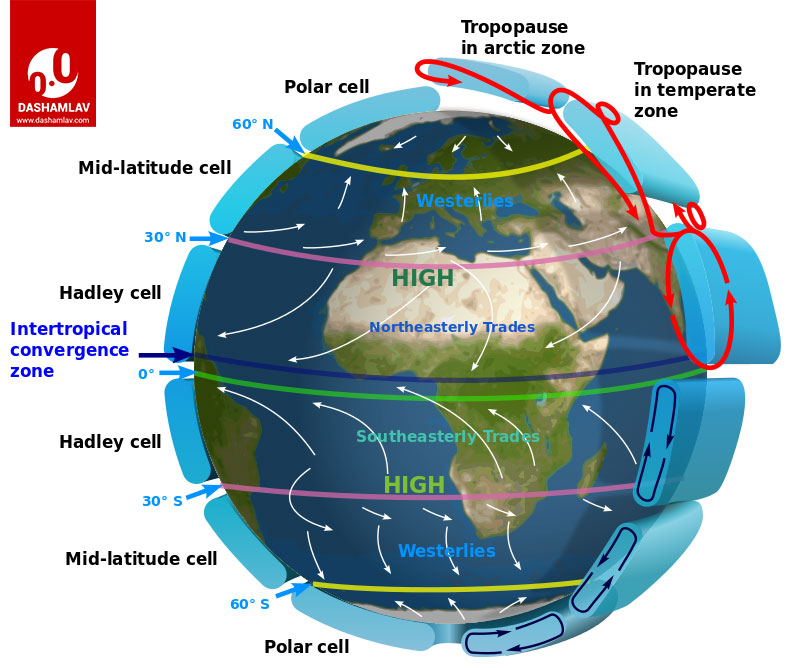Trade winds are permanent winds blowing from east to west towards the equator between horse latitudes. Horse latitudes represent the region at about 30 degrees north and south of the equator. Thus, they occur only near the equatorial region. Trade winds are also known as tropical easterlies.
Trade winds are very powerful prevailing winds of predictable nature. They blow from the north-east in the Northern Hemisphere and from the south-east in the Southern Hemisphere. Trade winds maintain a consistent force and direction. One can also understand these winds as air currents blowing very close to the surface of the Earth.
Across centuries, the trade winds have helped the sailors to navigate the world oceans and establish communication. These winds have played an instrumental role in facilitating trade and commerce between countries across continents. Even to date, world shipping relies heavily on the trade winds.
Causes of Trade Winds
There are two very important factors responsible for the trade winds: Hadley Cell atmospheric circulation and the Coriolis effect.
While Hadley Cell is the reason behind the formation of the trade winds, it is the Coriolis Effect that determines the direction of the trade winds. Let’s understand both these factors in detail.
1. Hadley Cell: Cause Behind Formation of Trade Winds
Earth’s atmospheric temperature and pressure are not the same at all places. This variance results in the creation of circulation especially between two different latitudes. This circulation is called the Hadley Cell.
Hadley Cell is basically a model of tropical atmospheric circulation responsible for the formation of the trade winds.
The Hadley cell forms a cycle that can be easily described in three stages:
- First Stage: Moist and warm equatorial air rises up and starts moving towards the tropics.
- Second Stage: The air flows at a height of 10-15 km above the surface of the Earth. After traveling for a few kilometers towards the tropics, the flowing air gets cooled and dried up. The dry cold air gradually starts descending at the sub-tropics. This is the stage where trade winds weaken.
- Third Stage: The cooler air in the sub-tropics changes its direction. The trade winds reverse or return back towards the equator forming a convection cycle and establish a wind pattern.
2. Coriolis Effect Deflection: Reason of Why Trade Winds Blow from East to West
It is a tendency of wind to flow from high pressure to low pressure. Accordingly, the winds blow from subtropical high-pressure belts on either side of the hemisphere towards the equatorial low-pressure belt as a part of the Hadley Cell air circulation process.
The strong trade winds, however, experience a deflection from its straight part while moving towards the equator from the sub-tropics.
This deflection is due to the Coriolis Effect which is caused by the rotation of the Earth on its axis.
As a result, the prevailing winds end up moving in a curved path towards the right in the Northern Hemisphere and left in the Southern Hemisphere.
Map and Direction of Trade Winds

Impact of Trade Winds
Some of the prominent impacts of trade winds are as follows:
Maritime activities
The trade winds greatly influence the maritime activities between the horse latitudes on both the hemispheres. While sailing along the course of trade winds benefit the sailors big-time, taking a reverse course against the strong trade winds is not a viable option.
Tropical rainforest
Trade winds, being permanent prevailing winds, continuously supply humidity towards the equatorial region. This deeply influences the physical geography of our Earth. As a result, hot and moist tropical rainforests are found near the equatorial region.
Trade-wind deserts
Trade winds deeply affect the climatic conditions of a region. Some of the biggest deserts of the world like Sahara, Australia, and Kalahari lie along the tropics. Very little precipitation coupled with extremely high temperatures and continuous removal of humidity ends up intensifying the desertification in these regions.
Impact over large landmasses
The trade winds have a very little or negligible impact on the large landmasses. Thus, the influence of trade winds is hardly experienced in continents like Africa or South America. This is because the local convection of air above these continents hinders with the trade winds cycle.
Trade Winds and El Nino
El Nino is a complex climate pattern associated with the unusual warming of water in the eastern tropical Pacific Ocean. During an El Nino event, the atmospheric pressure rises in the west and falls in the eastern Pacific. The reduction in pressure gradient weakens the westward blowing trade winds in the equatorial Pacific Ocean.
Use the citation below to add this article to your bibliography
"Trade Winds: Definition, Cause, Direction, Map, Impact & Important Facts." Dashamlav.com. Web. 12 June 2025. <https://dashamlav.com/trade-winds-meaning-cause-direction-map-impact-facts/>
Dashamlav.com, "Trade Winds: Definition, Cause, Direction, Map, Impact & Important Facts." Accessed 12 June 2025. https://dashamlav.com/trade-winds-meaning-cause-direction-map-impact-facts/
"Trade Winds: Definition, Cause, Direction, Map, Impact & Important Facts." (n.d.). Dashamlav.com. Retrieved 12 June 2025 from https://dashamlav.com/trade-winds-meaning-cause-direction-map-impact-facts/
